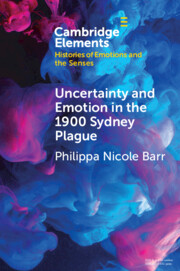Element contents
Uncertainty and Emotion in the 1900 Sydney Plague
Published online by Cambridge University Press: 16 February 2024
Summary
Keywords
- Type
- Element
- Information
- Online ISBN: 9781108908061Publisher: Cambridge University PressPrint publication: 11 April 2024

